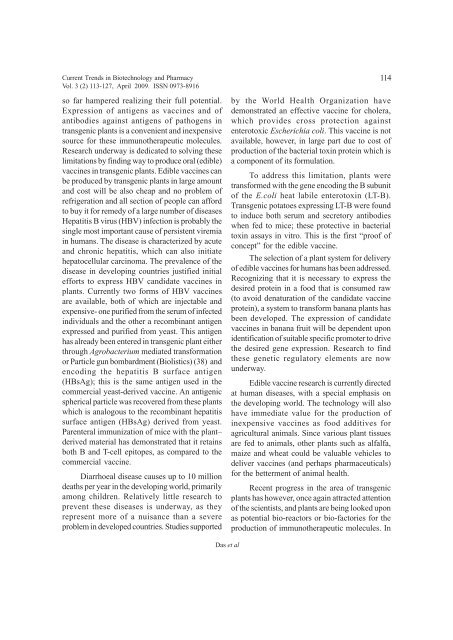April Journal-2009.p65 - Association of Biotechnology and Pharmacy
April Journal-2009.p65 - Association of Biotechnology and Pharmacy
April Journal-2009.p65 - Association of Biotechnology and Pharmacy
Create successful ePaper yourself
Turn your PDF publications into a flip-book with our unique Google optimized e-Paper software.
Current Trends in <strong>Biotechnology</strong> <strong>and</strong> <strong>Pharmacy</strong><br />
Vol. 3 (2) 113-127, <strong>April</strong> 2009. ISSN 0973-8916<br />
so far hampered realizing their full potential.<br />
Expression <strong>of</strong> antigens as vaccines <strong>and</strong> <strong>of</strong><br />
antibodies against antigens <strong>of</strong> pathogens in<br />
transgenic plants is a convenient <strong>and</strong> inexpensive<br />
source for these immunotherapeutic molecules.<br />
Research underway is dedicated to solving these<br />
limitations by finding way to produce oral (edible)<br />
vaccines in transgenic plants. Edible vaccines can<br />
be produced by transgenic plants in large amount<br />
<strong>and</strong> cost will be also cheap <strong>and</strong> no problem <strong>of</strong><br />
refrigeration <strong>and</strong> all section <strong>of</strong> people can afford<br />
to buy it for remedy <strong>of</strong> a large number <strong>of</strong> diseases<br />
Hepatitis B virus (HBV) infection is probably the<br />
single most important cause <strong>of</strong> persistent viremia<br />
in humans. The disease is characterized by acute<br />
<strong>and</strong> chronic hepatitis, which can also initiate<br />
hepatocellular carcinoma. The prevalence <strong>of</strong> the<br />
disease in developing countries justified initial<br />
efforts to express HBV c<strong>and</strong>idate vaccines in<br />
plants. Currently two forms <strong>of</strong> HBV vaccines<br />
are available, both <strong>of</strong> which are injectable <strong>and</strong><br />
expensive- one purified from the serum <strong>of</strong> infected<br />
individuals <strong>and</strong> the other a recombinant antigen<br />
expressed <strong>and</strong> purified from yeast. This antigen<br />
has already been entered in transgenic plant either<br />
through Agrobacterium mediated transformation<br />
or Particle gun bombardment (Biolistics) (38) <strong>and</strong><br />
encoding the hepatitis B surface antigen<br />
(HBsAg); this is the same antigen used in the<br />
commercial yeast-derived vaccine. An antigenic<br />
spherical particle was recovered from these plants<br />
which is analogous to the recombinant hepatitis<br />
surface antigen (HBsAg) derived from yeast.<br />
Parenteral immunization <strong>of</strong> mice with the plant–<br />
derived material has demonstrated that it retains<br />
both B <strong>and</strong> T-cell epitopes, as compared to the<br />
commercial vaccine.<br />
Diarrhoeal disease causes up to 10 million<br />
deaths per year in the developing world, primarily<br />
among children. Relatively little research to<br />
prevent these diseases is underway, as they<br />
represent more <strong>of</strong> a nuisance than a severe<br />
problem in developed countries. Studies supported<br />
114<br />
by the World Health Organization have<br />
demonstrated an effective vaccine for cholera,<br />
which provides cross protection against<br />
enterotoxic Escherichia coli. This vaccine is not<br />
available, however, in large part due to cost <strong>of</strong><br />
production <strong>of</strong> the bacterial toxin protein which is<br />
a component <strong>of</strong> its formulation.<br />
To address this limitation, plants were<br />
transformed with the gene encoding the B subunit<br />
<strong>of</strong> the E.coli heat labile enterotoxin (LT-B).<br />
Transgenic potatoes expressing LT-B were found<br />
to induce both serum <strong>and</strong> secretory antibodies<br />
when fed to mice; these protective in bacterial<br />
toxin assays in vitro. This is the first “pro<strong>of</strong> <strong>of</strong><br />
concept” for the edible vaccine.<br />
The selection <strong>of</strong> a plant system for delivery<br />
<strong>of</strong> edible vaccines for humans has been addressed.<br />
Recognizing that it is necessary to express the<br />
desired protein in a food that is consumed raw<br />
(to avoid denaturation <strong>of</strong> the c<strong>and</strong>idate vaccine<br />
protein), a system to transform banana plants has<br />
been developed. The expression <strong>of</strong> c<strong>and</strong>idate<br />
vaccines in banana fruit will be dependent upon<br />
identification <strong>of</strong> suitable specific promoter to drive<br />
the desired gene expression. Research to find<br />
these genetic regulatory elements are now<br />
underway.<br />
Edible vaccine research is currently directed<br />
at human diseases, with a special emphasis on<br />
the developing world. The technology will also<br />
have immediate value for the production <strong>of</strong><br />
inexpensive vaccines as food additives for<br />
agricultural animals. Since various plant tissues<br />
are fed to animals, other plants such as alfalfa,<br />
maize <strong>and</strong> wheat could be valuable vehicles to<br />
deliver vaccines (<strong>and</strong> perhaps pharmaceuticals)<br />
for the betterment <strong>of</strong> animal health.<br />
Recent progress in the area <strong>of</strong> transgenic<br />
plants has however, once again attracted attention<br />
<strong>of</strong> the scientists, <strong>and</strong> plants are being looked upon<br />
as potential bio-reactors or bio-factories for the<br />
production <strong>of</strong> immunotherapeutic molecules. In<br />
Das et al













